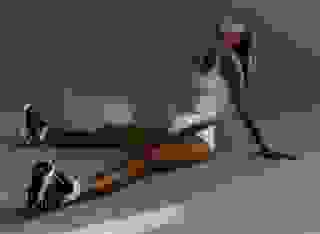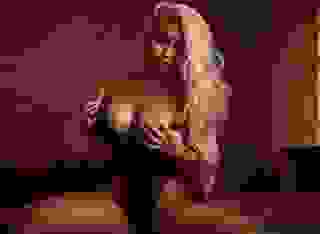- Non-Erotic
- Leaving Home
- Page 2
Note: You can change font size, font face, and turn on dark mode by clicking the "A" icon tab in the Story Info Box.
You can temporarily switch back to a Classic Literotica® experience during our ongoing public Beta testing. Please consider leaving feedback on issues you experience or suggest improvements.
Click hereThis is what I learned from our talks. Ali spoke Mandarin fluently and bantered with the team as they asked questions and shared answers. When she had time she translated for me. She gave me access to the company plans and specs. I asked her the overall goal of the Chinese.
They planned a large installation within 100 kilometres of the Lunar north pole. This would allow their team to work without the harsh hot days at the equator and the 14 day bone chilling nights.
Crater Plato was to become our starting point. It was far enough from European and American claims, but the Chinese were not waiting or asking permission. They had already a base to the south. Now directly north was the beginnings of a large solar farm to feed a thirsty settlement the power that it would need. This is close to the spot of the first Chinese new regime soft landing.
They wanted four underground habitats. These holes in the crater wall would house 5000 people. They needed us to create a base for further solar-system exploration.
Each habitat is constructed by boring, using the redesigned equipment, TBMs. Impress 100 tunnels, 3 kilometres into the side of the crater north wall. That would start the living quarters at about 500 metres below the average lunar surface. Lots of rock to protect delicate skin from the gama and beta rays of vacuum space. There is no atmosphere on the Moon for protection.
Tunnels will be created close enough that in between walls can be removed to make larger living spaces. Separate caverns will be constructed to provide agricultural sites. Recreational areas. Industrial work places. Equipment and utility space. All with a 3.4 metre bore diameter. One tunnel is adequate to produce a hallway. People and children will need that height in one sixth gravity, to not keep hitting their heads.
Coming into Orbit - Xing Xing, Yvette, Zoraida
It was the last stop before we descended to the Moon's surface. Ali had been up front in the pilots cabin, leaving me alone and free to glance around. I wondered what she was doing as no crews were on the shuttle. Workers were entering the ship from the rear. I got no new companion.
On the last day, there must have been an airlock attached, as the air pressure did not change much. Three beautiful red heads stood in the aisle looking over the team. They were dressed in tight pink spacesuits without their helmets. Not Chinese but identical native beauties.
The one labeled Xing Xing spoke for the three. "We have brought suits for everyone and we will help you to dress. Please slip down to your underwear and remove all jewelry." Ali translated from the front into Mandarin.
Modesty was not a part of space travel yet. They must have known our sizes as my suit fit well. I knew what was about to come, but still it was not to my liking. We left in groups of 15 or so. I was in the last group. Xing Xing was giving me special attention. I don't imagine these things.
When I looked out the airlock door there was only two ropes and a platform of open strut triangles. On the platform were canvas seats for each person and a sturdy seat belt.
The moon hung above us or was that below? The pilot, another woman, of our vehicle was sitting now in a substantial seat at the mid-point. She had a panel before her, which she consulted and when everyone was strapped in, she wasted no time in firing the jets and eventually flipping us over to come to a landing in our very own Lunar crater, Plato, depth one kilometre, diameter 100km. We landed near North Wall.
We were all unseated by assistants. They lead us to the temporary quarters of some foam and cloth built structures, air tight and air filled but a little lacking in space. We were shown to our bunks and told that the only public space was the cafeteria. When I had everything stowed, Ali arrived to put me to work.
"You will not be using the same suit because your job will require you being out in the radiation for hours every day. Much of the work will be done under great canopies, a protective roof-like covering, stretched over a number of square kilometres of crater floor, but it only protects you from the sunlight and heat." After I donned the new suit, she lead me outside to a spot where boxes were strewn about.
Five suited people stood about. "Anthony. This is your assembly team. Fred, Robert, Xing Xing, Yvette and Zoraida. I figured your not fluent in Chinese so we borrowed them from the orbital crew. They are very good at assembly, as they have built all the structures in orbit, both here and around Earth." she concluded, then she marched off to troubleshoot a problem with the water separators.
Chapter 4 : The North Wall
When I arrived Ali had my crew ready but I asked for a few hours to survey the site. Xing Xing was there and she volunteered to answer any questions.
The north wall was massive and wide, 50km wide and 1km high. There was substantial debris from the backsliding of materials since the meteor impact. The debris on impact had flung for many kilometers in every direction and Plato acquired a irregular rim, rising from a kilometer to 2.1km in height. Earlier crews had spent much time testing and probing the rim rocks to find the most stable place to start work on the tunnels. Dozers had worked weeks finding the flat surface.
Conveyors were set up at the work site to move materials away, to a holding area. Large canopies were held up with poles, spread out above the work area. This was a shelter from the bright sun and it stopped equipment from overheating. It was a light parachute-like material provided by Candle Lake. The work space was bright enough in the lunar day and also reflected artificial lighting in the dark. On North Wall, there is a lot of shadow so artificial light was what we worked with. The cold was severe and tested the heating systems in our suits.
There was an attempt to make a straight piece of wall at the crater floor. Machines had moved a mountain of debris off to a holding area.[4] It was estimated that if we tunneled from floor level parts of the 3km tunnels would be 500m below the exterior moon surface (beyond the rim). When my crew started working the next week we made a tunnel about 20m above the floor just to see the condition of the rock and how much cracking and rubble were in the tunnel. After the exterior rubble had been removed we only found instability in the first 100m of rock.
This we could stabilize using thin fiber panels that bend easily to the tunnel circumference. We decided that tunneling higher up would be no worse and began the boring of 3 more parallel tunnels side by side. It would also be faster and less work to have the conveyors working near flat ground.
The tough material carrying the rock (on the conveyors) was again a multiple layer cloth compound. They thought it up in Candle Lake. A whole aircraft hangar had been taken over and just like rope making, the cloth was stretched the length of the building and turned back and forth as layers of cloth and composite materials were sown in by large stitcher machines. It received a protective rubber spray as it went through the final routing. The belt was rolled into a huge bundle, more than a ton (metric). This was shipped off to the railgun station on an airship. The airship could, if it had to, carry 80 of these. The railgun rockets reached capacity with one roll of this material.
The secret of the cloth surviving heavy workouts was to run the conveyor slowly. Every object on the moon still has its same inertial mass, so sharp edges can cut through cloth if the speed is unreasonable. Another technique was to not put too much of a slope on the conveyor system. Rolling sharp rocks cause damage. But we had contingency plans for cloth repair. But people were another thing.
Projecting the TBM plans, blown up, on a side panel of the protecting screen, we worked out the best and fastest method to assembling the two tunneling machines. I had studied the plans on the trip over. It was a much simplified version of the machines I used in B.C.
My crew were a very clever bunch. You don't live long in space if you are otherwise. I made it plain that I was training them to train the Chinese. I did not know how long I would have on this gig.
Then because we were deep on the bottom of a crater, up against a North wall, we used a jacking rig to raise the first machine to the twenty meter point with power lines from distant banks of solar cells, we began boring the first set of what would be hundreds of tunnels. These holes were to a depth or distance of three kilometre. Four parallel tunnels separated by less than half a metre of rock. When the first three were finished a separate crew organized by Ali, went in with cutting machinery, based on mechanical and laser cutters used on Earth. They cleared away the remaining side rock. Soon the tunnels were sealed up with one airlock giving entrance. Beside it was a long oal window.
The TBMs worked three times as well here in vacuum. The big problem on Earth is the constant change in the hardness of the rock. This is caused mostly by ground water. We were now only dealing with frozen water. Deep frozen water, that probably thought itself to be rock. It was good and hard at this depth. The tunnels would start out with a temperature of just -15C.
The middle two tunnels would become accommodations. The left tunnel was for access, a hallway, the right tunnel was a utility tunnel handling all the electrics, pipes, drainage, ventilation, heating and atmosphere controls, etc. A shorter fifth tunnel provided a water storage tank.
* * *
I approached the slim woman with the can-do attitude and asked her for a private room with a real door.
"You would be surprised how many people have asked the same. I have noticed you and Xing Xing are getting along." she commented. I assumed she was going to help with my room as she changed the subject.
Ali designed the apartments for people living in the temporary inflatable habitats. Within a month we had moved ourselves into a radiation safe zone. We were a little short on air, especially nitrogen and the air pressure was low, but it was breathable.
From the rock removed by the tunneling machines, T1 and T2, they had discovered a wealth of frozen water ice. It was fortunate because we needed the water for the many functions preparing the settlement and the crew, and then there was the rocket fuel.
A massive supply of liquid air was being freighted from Earth as we were completing the first project. Mainly because we needed the nitrogen but also the oxygen and other gases. It was also much easier to compress the clear mountain air very near the rail launcher then to separate it into parts. It was also safer to sling into orbit as the nitrogen is somewhat inert.
We had a little celebration as we moved into our first habitat. The limited habitat was not much but it was safe and warm. I got my single room as did Xing Xing right next door. All the single rooms were near the airlock.
The kitchens were about 400 meters down the hall, the eating area next to it and the washrooms and showers were on the other side of the eating area.
Ali wasted no time and called 30 of us together about 10am the next morning. Neither she nor anyone else looked sharp, after the night before. I handed Ali a coffee as she entered the dining area.
"Got a splitting headache but what else is new?" said Ali in my ear. Then out loud she said, "Good morning crew. The first step is finished and now we must plan for the first official habitat. It is the first of four as you know." she spoke as the supervisor.
Some of the crew were plugged into their translators. The room was 20--10 Pure Chinese to Canadian mongrels.
"The teams that have been trained to run the tunnel worms have arrived and the equipment awaits outside. They know the complex structures that we are going to build.[5] Many will be four kilometers long, others will be up to five kilometers. There will be apartments for family units or groups that want to live as families. There will be large agricultural spaces, some room for shopping and leisure, and areas for industrial enterprises."
We would discuss all the details before lunch. My team was being split up as we each had practical experience with the first tunnels. There were 6 new machines, T3 to T8 and only one machine would be out of service for maintenance at any one time.
It was only 20 days into the tunneling. Then I was on special assignment with Ali McLean.
At lunch Ali pulled me aside. "I lied. You are coming with me. Bring your work suit to the airlock." Then she was off.
She led me down to the elevator which was outside, up against the crater wall. I touched her helmet and she looked around as my words of inquiry reached her.
I said, "I had Doris inbed a local radio transceiver in my right suit glove. Works on vibration. No one can hear us. I just need to touch someone's helmet."
Ali said, "Handy. I will have to get one of those."
"You still have to turn off your suit radio or they can hear both of us." I answered.
"I put it on receive." Ali answered.
"Where are we going?" I asked as we reached the crater floor.
"We are going south to the far wall. I have T9 waiting for us."
"So you did lie. One unregistered machine out of site on a special mission."
"You said it. And I have a fast rover waiting for us." We jumped into a new model of a 6 wheeler, I had not seen it before. We were soon moving south and hit a fresh narrow highway.
"Where has this road come from?" I asked.
"It was necessary to experiment with the gravel mixes we have been working on." she explained. "The junk rock that is discarded from the separation process, it has to be used for something. We used standard gravel making procedures from Earth. Conveyors and screens. Then the gravels are mixed. After we graded the road foundation and rolled it, we laid down different layers of gravel mix to get the best surface. What we have now acts a little like asphalt, when it has been rolled well." Ali said. "Sit back and relax. It will be an hour before we arrive." She was driving.
The rover rolled and jerked some but was moving faster than I thought possible. Ali, at her word, brought the rover up to the south wall face. Debris had been removed at the base, so we were looking at a vertical section mostly in shadow. We were under a large section of parachute canopy. Only some of the light got down to us. A shiny TBM sat up against the wall. I wondered what I was here for. Some one else had assembled the beast.
"The men who are here are my own team and they are sworn to secrecy. This project is not on the map." I was using my glove radio as she talked. "You will drill from ground level and 15 degrees to the right. One long tunnel until I tell you to stop. It won't be more than 7km."
I got the machine angled and started as the team scrambled with the conveyers and another group brought 'what we referred to as a moon trailer'. We were not leaving the site until the job was done. We had a bank of chemical battery systems running on methanol. The electricity was sufficient just for the long haul tunneling.
Ali was giving me hints about where this hole was going. Moon history was rife with volcanic events mostly back 3 billion years ago. These eruptions produced a number of lava tubes. Most collapsed over historical time. Some left holes in the Lunar surface but were less useful as the effort to seal them was labour intensive. Surveys had revealed three tubes near the Plato Crater. These tubes seemed to be mostly intact and deep. We would know better on investigation.
"We don't know what we will find, but if the tube is stable and airtight then it could be used for settlement." Ali wondered.
"You trying to pull a fast one on the Chinese?" I asked in a kidding voice.
"You bet. And our lives may depend on this find." she answered. "We also have another TBM in orbit that will remove rock from the side walls of the round tunnels. It will save us a lot of trouble. The chinese will get theirs as well."[6]
When T9 reached the spot, Ali signed me to pull it back and had the electric hand tools brought in. We spent a long period making our way down the long tunnel. There was a puff of gas as we broke through but nothing dramatic. Just a little water vapour. Ali crawled through first, and I followed her. She was sprawled a couple of metres below me on a dusty scree bank.
"You alright?" I asked.
"Ya! I am fine." Ali answered.
I jumped down beside her and we moved carefully down the dusty slope to reach the midpoint in the tube. Three of the workers hauled lighting equipment through the hole and cables borrowed from T9. Soon we were seeing something, that no one had ever seen before.
My laser rule said it was 300 metres across, about 230 metres high and more than 3km east and a similar distance west. We needed to explore a lot more, but our two hours of walking about revealed no light from the surface and the only collapses were at the east end. Nothing that endangered the integrity of the tube. The temperature was about -15C. We don't measure the air because there is none, but slipping a probe between two rocks works.
"When the time comes I want to seal the walls and move 5000 people in here. But for now we seal off the entrance and start working on the nano factory project. Mum's the word. Nano factory tunnels. That is what we are here for. Distant from the populated areas. No dust nor vibration. " Ali explained.
"At your service mam. We leave the tube and it waits for now." and I bowed to her.
We continued over the next week to tunnel four more holes. Three below, two above and then Ali had the walls and floors removed, (with the specialized TBM, to make the walls straight) forming a rough triangle as the factory workspace. A special mixture of spray epoxy was developed to seal the walls and inhibit any dust. The inside surfaces would be easy to clean.
I told this unusual woman I was needing to get home. "I don't want to loose too much muscle tone. I think Doris is expecting me back."
"Yes, I know. I got one more job for you." she added.
Chapter 5 : Natural Champagne Gems
We drove 10km west along the south wall. There was again the signs, of a crew having cleared the debris from the wall. T9 was again in place and I asked what was planned for this place.
"Well it would not make much sense to build such a fine road and only build one facility. We need people working in it. This is the location of Hab 5. We will be doing a little work on it, ahead of schedule. H1 habitat is now under construction on North Wall but I can tell them I am doing some test drilling just to see if it makes sense to have a habitat one hundred kilometres away from the main wall." Ali explained.
After a good meal and a rest, I set the machine in motion and the team scrambled. 4km in, Ali gave the signal to halt. I reversed the machine so we could do a little hand work on the face.
"You will not need those tools." said Xing Xing. "I got what you want in my bag."
"Ah! You women are full of surprises." I was full of wisdom.
"Not any more than I was when you did not try to sleep with me. Ali tells me you got something on with Doris." Xing Xing commented.
"Well I was thinking about you." I said lamely. She did not seem happy with my comment. It was true I had thought her a wonderful beauty, but I needed a linking of minds, a joining of souls.
"Ali said there was some diamond work for me here. If that is true then your machine is about to meet the dragon."
We knocked away some of the face and out of rough rock appeared brown glassy crystals as big as my fist.
The woman said, "Step back. You do not want to be struck by this stuff. What a beautiful colour!" She went at it with her small hammer and chisel. Ali was standing by me. I touched her helmet.







